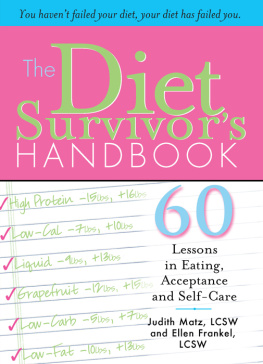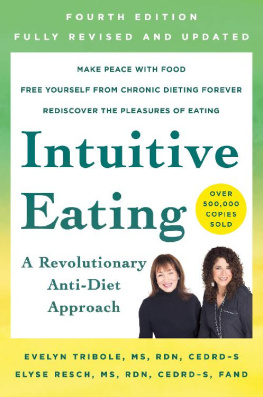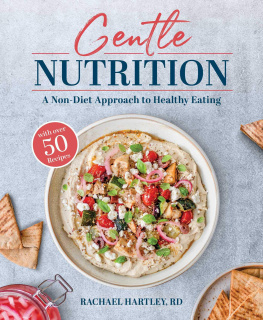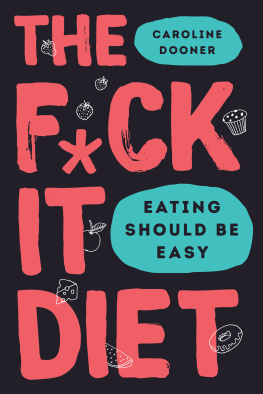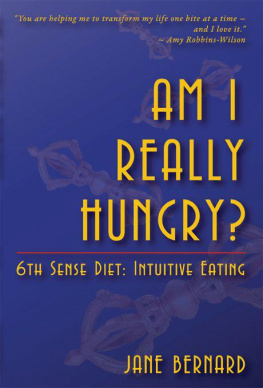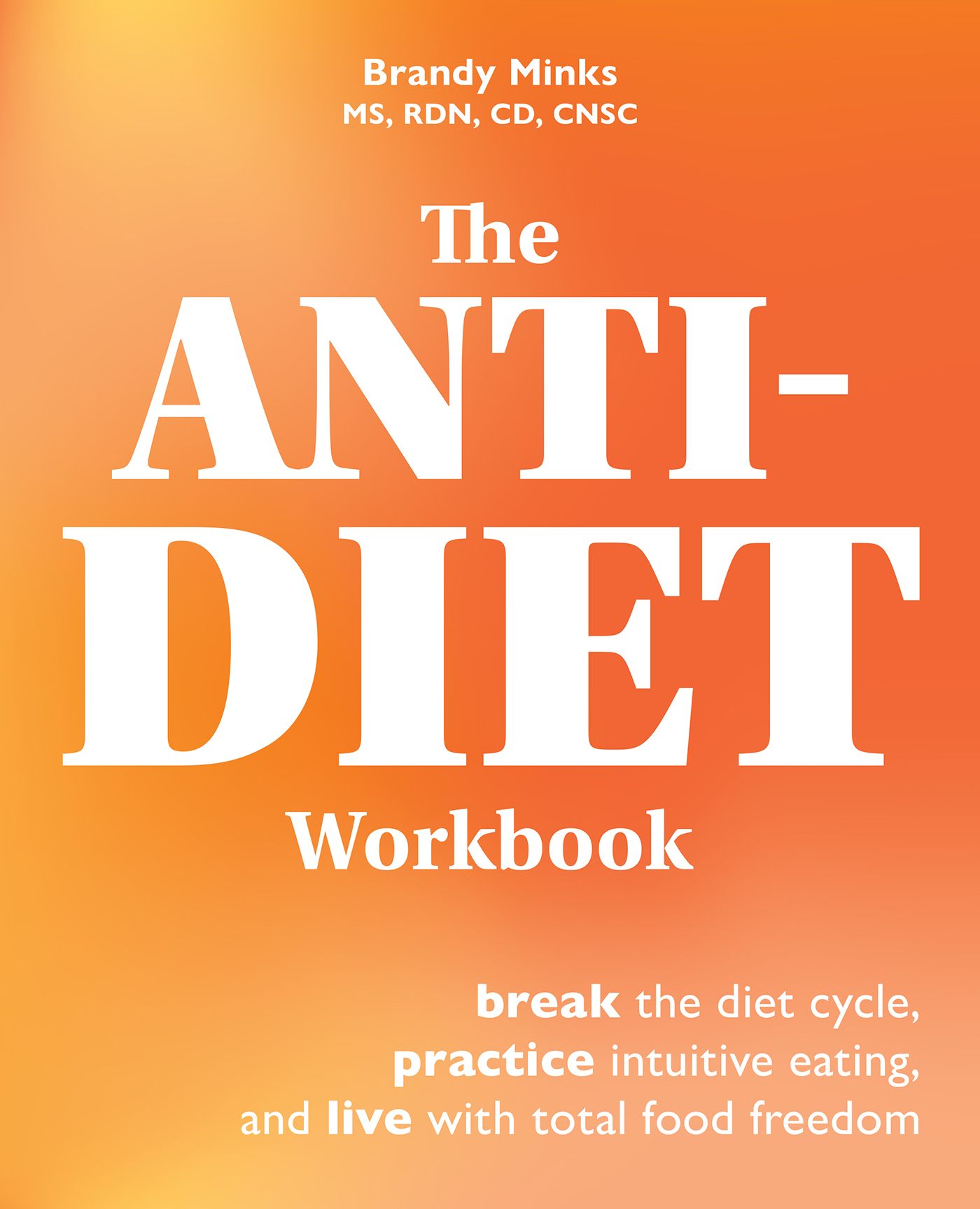Contents
Guide
Brandy Minks Ms, RDN, CD, CNSC
The Anti-Diet Workbook
Break the Diet Cycle, Practice Intuitive Eating, and Live with Total Food Freedom
Text copyright 2022 Brandy Minks. Design and concept copyright 2022 Ulysses Press and its licensors. All rights reserved. Any unauthorized duplication in whole or in part or dissemination of this edition by any means (including but not limited to photocopying, electronic devices, digital versions, and the internet) will be prosecuted to the fullest extent of the law.
Published by:
ULYSSES PRESS
PO Box 3440
Berkeley, CA 94703
www.ulyssespress.com
ISBN: 978-1-64604-309-5
ISBN: 978-1-64604-321-7 (e-book)
Library of Congress Control Number: 2021946380
Acquisitions editor: Ashten Evans
Managing editor: Claire Chun
Editor: Kathy Kaiser
Proofreader: Renee Rutledge
Front cover design: Justin Shirley
Interior design: what!design @ whatweb.com
Production: Jake Flaherty
NOTE TO READERS: This book has been written and published strictly for informational purposes, and in no way should it be used as a substitute for consultation with your medical doctor or health-care professional. All facts in this book came from medical files, clinical journals, scientific publications, personal interviews, published trade books, self-published materials by experts, magazine articles, and the personal-practice experiences of the authorities quoted or sources cited. You should not consider educational material herein to be the practice of medicine or to replace consultation with a physician or other medical practitioner. The author and publisher are providing you with information in this work so that you can have the knowledge and can choose, at your own risk, to act on that knowledge. The author and publisher also urge all readers to be aware of their health status and to consult health professionals before beginning any health program, including changes in dietary habits.
To whom Ive harmed with diets: Im sorry, and I hope you can find food freedom.
Introduction
Dear Reader,
Im so excited that you have picked up this book! It means you are interested in changing your outlook on your body and how you view health. There is a movement in the world today called Health at Every Size (HAES), which promotes body acceptance and sheds light on our societys bias against higher-weight bodies. Along with this movement is the intuitive eating (IE) framework, famous for leading people out of the dieting and weight loss world, and into a healthier relationship with food and the body. I will be referring to both HAES and IE, but in addition to this workbook, I encourage you to read books devoted to these topics (see appendix A for recommended titles and more).
There are a few things I need to mention before you delve in. I am an anti-diet dietitian. I do not condone dieting for weight loss or using weight loss as a treatment for illness. In treating my patients, I do not provide food or calorie restriction. As youll read in this book, there are many diets or restrictive eating patterns that can cause harm. Being anti-diet does not mean that I disregard well-researched medical nutrition therapy to treat specific diseases, such as for kidney disease. If you are following a certain diet to treat a condition, this does not mean that you cant do intuitive eating! If you do have a special diet, I highly recommend working with a certified IE dietitian, who can provide specific guidance for your bodys needs.
In this book I use weight and calorie numbers in certain chapters as they pertain to my own story, to the stories of my patients (whose names I have changed to protect their identities), and to body mass index (BMI) and other research presented. Other anti-diet books tend to remove these numbers, as they can sometimes trigger negative feelings in the reader or even become a how-to guide for someone looking for the next diet to try. I use numbers in certain parts of this book where I need them to prove my points. Stay aware of your feelings as you read and skip over parts as you need to.
Now lets talk about verbiage. I use the word fat in this book in a literal sense. While the term is considered derogatory slang, fat people are reclaiming it as a descriptor, just like calling someone tall. The same approach has been used in the LGTBQ+ community, where they embrace terms that have historically been used to shame and marginalize them. Terms such as obese or overweight are considered weight-stigmatizing as they pathologize higher-weight bodies. I use these O words on occasion in this text when talking about pertinent research (such as in Chapter 2), but I mostly use neutral descriptive words.
This workbook is intended for the person who is ready to develop a better relationship with their body and rediscover the intuitive eater we all have within. You may be unhappy with your body. You may have attempted diets in order to lose weight, change your body size, or get healthier. Or you may have disordered eating habits or a disordered mindset around food or your body. The following are descriptions of some disordered eating practices as well as common eating disorders. A person may have disordered eating if they exhibit any of these behaviors in part or in whole (in Chapter 4, you will take a quiz to help you determine what specific disordered eating behaviors you may exhibit). People with disordered eating are at higher risk for developing an eating disorder.
- Binge eating: This behavior results from restriction (physical restriction, such as eating fewer calories or avoiding certain foods, or mental restriction, such as telling yourself you will stop bingeing starting tomorrow), which leads to strong food cravings. Bingeing is associated with eating an unusually large amount of food in one sitting; the person who binges feels guilt and shame for having eaten so much and typically feels out of control with food.
- Orthorexia: The person with this condition spends an abnormal amount of time thinking about food and health. They are obsessed with eating only the right foods or what they deem the healthiest foods. They may have food rules that do not allow them to eat unhealthy foods, or they may eliminate certain foods from their diet in pursuit of health. Other behaviors typical for this person are tracking calories or macronutrients; compulsively checking food labels and ingredient lists; writing down everything they eat; showing high levels of distress or anxiety when healthy foods are not available; and constantly thinking about the next meal.
- Emotional eating: The person who eats this way does so to soothe their emotional state, not because they are physically hungry. They might eat when faced with any emotion, but will typically do so when negative feelings arise, such as sadness, anger, anxiety, stress, depression, fear, loneliness, or even boredom (well talk about emotional eating in more depth in Chapter 4 when we discuss intuitive eating). Emotional eating is not always disordered but can be if it leads to further distress or bingeing.
- Eating in secret: The person who eats in secret waits to eat until they are alone and does not want others to see or judge them for the type or amount of food they are eating. This could look like accepting a treat from a coworker but waiting until they are alone in the car to eat it; waking up in the night to have a snack so that others living with them do not see; or hiding food wrappers so that no one sees the wrappers in the trash.


